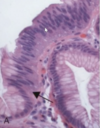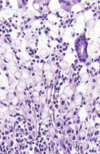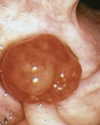B5.071 - GI Tubal Cancers COPY Flashcards
describe adenocarcinoma in the esophagus
distal esophagus
arises from Barretts
more common than squamous
types of cancer in the stomach
adenocarcinoma (most common)
lymphoma (H. plyori)
neuroendocrine (MEN1)
gastrointestinal stromal tumor (GIST)

villous adenoma of colon with long sleder projections that are reminiscent of small intestinal villi
microscopic appearance of esoph squamou cell carcinoma
dysplastic/atypical squamous epithelium invading into submucosa or deeper
variably sized nests of tumor cells with epithelioid cells, ample eisinophilic cytoplasm, keratinization
describe lynch syndrome
pts do no have multiple polyps
often cancer at earlier age
follows microsattelite instablle pathway
germline mutations in mismatch repair proteins
precursor lesion for squamousc cell carcinoma of esophagus
squamous dysplasia, plaque like thickening

dysplasia in barretts esophagus
abrupt transition from barrett metaplasia to low grade dysplasia
note nuclear stratification and hyperchromasia
risk factors for carcinoid tumor
MEN-1, AMAG
presentation of GIST
asymptomatic
sx due to mass effect when large, may ulcerate causing bleeding
diffuse type stomach adenocarcinoma features
gross: diffues thickening (linitis platsica)
micro: sheets of cells sometimes signet ring
associated with hereditary gastric cx
mutations in CDH1 (e-cadherin)
pts also have lobular breast cx
describe squamous cancer of esophagus
middle/upper esophagus
not assoicated with barretts
more common world wide
location of esophageal adenocarcinoma
distal 1/3 of esophagus
presentation of esophageal adenocarcinoma
long standing GERD
odynophagia or dysphagia
weight loss, vomiting. hematemesis
location and clinical presentation of squamous cell carcinoma of esophagus
mid esophagus or upper
dysphagia, odynophagia, obstruction
weight loss
what is a hyperplastic polyp
not considered a precursor to adenocarcinoma
microscopic shows serrated polyp without dilation at the base

neuroendocrine tumor
molecular features of GIST
most have activating mutation in KIT gene
some have activating mutation in PDGFRA
treatment with imatinib only works in tumors with mutations in these genes
risk factors for esoph squamous cell carcinoma
smoking, alcohol, esophageal injury, achalasia, frequent consumption of very hot beverages, radiation, lower SES
more common in iran, china, brazil, SA
pathogenesis of colon adenocarcinoma (2 pathways)
stepwise collection of multiple mutations
APD/beta catenin pathway
microsattelite instable pathway

GIST

barrett
architectural irregularities, including gland within glad or “cribiform” profiles in high grade dysplasia
risk factors for lymphoma
chronic inflammation, H. pylori (eradication of H pylori can resolve lymphoma in early stage)
intestinal type stomach adenocarcinoma features
gross: mass lesion, often ulcerated
micro: intiltrating atypical glands with mucin production
associated with intestinal metaplasia, FAP, H. pylori
describe barretts esophagus
replacement with columnar epithelium and goblet cells
resonse to repeated injury of reflux (10% of pts with GERD)
may develop dysplasia
what do you do for barretts with high grade dysplasia
surveillance if single focus
laser ablation, endoscopic resection
risk factor for GIST
NF1
treatment for esoph. squamous cell carcinoma
chemo/radiation
surgery

high grade dysplasia
dysplastic cells extend to surface of the epithelium and are associated with significant loss of surface maturation
squamous cell carcinoma of esophagus

GIST
molecular alterations of stomach adenocarcinoma
mutation of TP53
may displat MSI
ERBB2 (HER2) in intestinal type
CDH1 lost in most diffuse type cancers

tubular adenoma
smooth surface rounded glands
important hereditary considerations for colon adenocarcinoma
FAP - germline APC considerations
Lynch syndrome (HNPCC, hereditary non polyposis colorectal cancer)
describe FAP
many polyps which are tubular adenomas
follows traditional APC pathway
often have cancer at early age
treatment of neuroendocrine tumor and prognosis
resection
prognosis - good cured after resection, sporadic may be more aggresseive
presentation of carcinoid tumor
if functional - zollinger ellison syndrome
carcinoid syndrome - cutaneous flushing, bronchospasm, sweating, abdominal pain, diarrhea
presentation of colon adenocarcinoma
no signs/sx early
advanced on left side - change in bowel habits abdominal distention, hematochezia (if ulcerates)
right side - fatigue, weight loss, anemia
describe the microsattelite instable pathway in colon adenocarcinoma
deficiency in mismatch repair proteins
precursor lesion often the sessile serrate adenoma
do not respond well to traditional chemo
more commonly right sided
what is GIST
most common mesenchymal tumor of the abdomen
more than 1/2 arise in stomach
arise from interstitial cells of cajal within muscularis propria
gross appearance of esoph squamous cell carcinoma
mass like lesion, may protrude into lumen, ulcerate
may infiltrate and cause diffsue thickening
risk factors for esophageal adenocarcinoma
GERD, obesity, tobacco, alcohol, radiation

intestinal type stomach adenocarcinoma
treatment of GIST
resection
imatinib for unresectable, metastatic or recurrent that has KIT or PDGFRA mutations
































